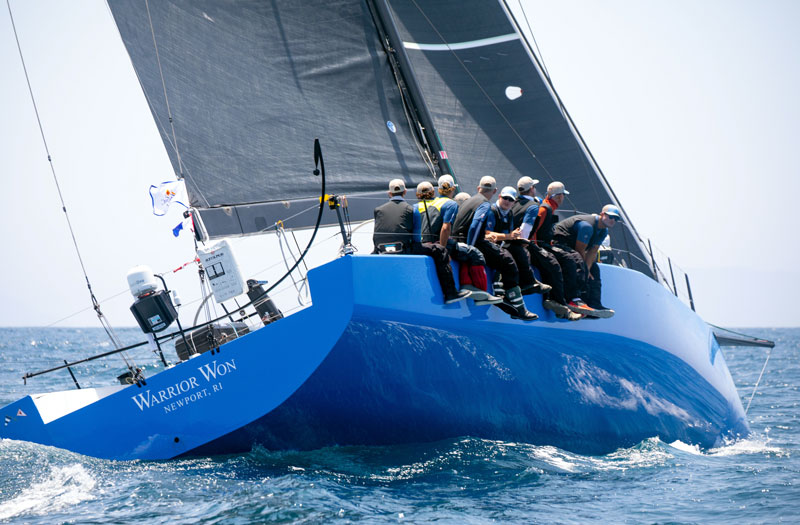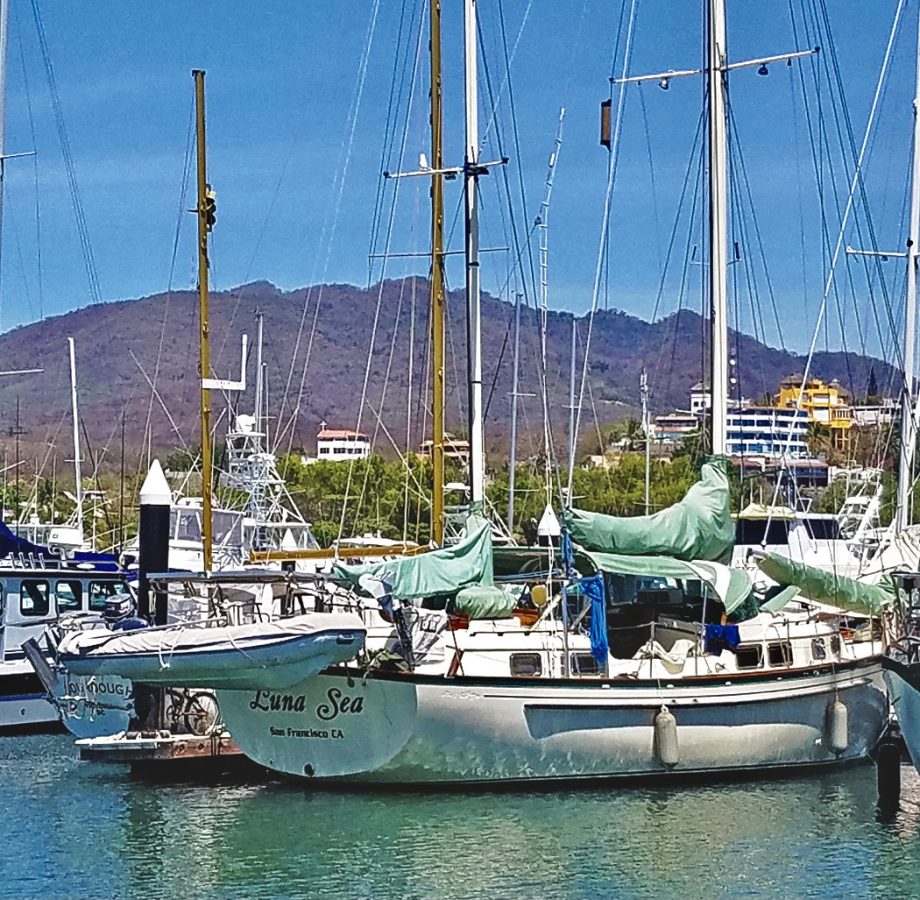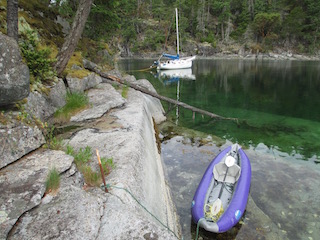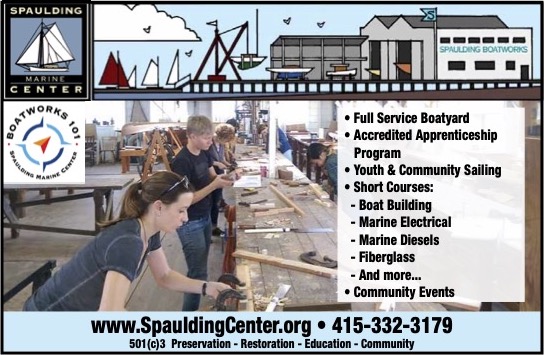
First Transpac Finishers Arrive in Oahu
First Finishers
As this article ‘goes to press’, the first finishers in the 2021 Transpac race have begun to sail across the finish line at Diamond Head Buoy. First to finish, at 2:53 a.m. HST, was Roy P. Disney’s turboed Volvo 70 Pyewacket 70, which sailed the 2,217-mile course in a provisional time of 5 days, 16 hours and 23 minutes. They were tied up at the dock and drinking mai tais by the time we wrote this. Not only was Pyewacket the first boat to reach Honolulu, but the former round-the-world racer will also claim the coveted Barn Door Trophy given for the monohull with the fastest elapsed time.

Cecil and Alyson Rossi’s Farr 57 Ho’okolohe will probably have finished by the time you read this. The fastest boat to start on the first day of starts, Ho’okolohe had been well out in front of the fleet the whole way since leaving Long Beach, only to get passed by a much, much faster boat right before the finish. The most current tracker data shows Ho’okolohe correcting out to a win in Division 8. Pyewacket is likely to end up in second place in Division1, though she still has a shot to win if the J/V 72 Lucky should lose some steam approaching the finish.
Overall Leaders
Behind the boats that will be first into Honolulu, the rest of the fleet is making great time in picture-perfect conditions. With a strong and stable Pacific High blanketing the course in steady trade winds since the start, Transpac 51 is turning into a fast year for this relatively small fleet of just 40 boats. Leading the race overall is a pair of blue 52-footers heavily influenced by the TP52 box rule. Chris Sheehan’s baby-blue Pac52 Warrior Won currently sits atop the ORR Overall ratings, though Thomas Furlong’s beautiful dark-blue R/P 52 Vitesse is nipping at their heels. A couple of sleds and a Rogers 46 round out the top five on overall corrected time.

Bay Area Transpac Teams
Notable Bay Area boats include Dave MacEwen’s Rogers 46 Lucky Duck, which sits second in Division 5 and eighth place overall as of this writing. Rufus Sjoberg’s J/125 Rufless is not far behind Lucky Duck in fourth, in what has become a very closely contested Division 5. Mike Moradzadeh’s Santa Cruz 50 Oaxaca is locked into a close battle in Division 6, while Greg Dorn’s Dehler 46 Favonious has a commanding lead in Division 7. Several other Bay Area yachts are also leaving their mark on the race.

A Cautious Honolulu Aloha
When Transpac racers get to Hawaii, they’ll have a decidedly different experience than in years past. As part of Transpac’s efforts to remain as safe as possible during these pandemic times, individual awards and perpetual trophies will be presented to teams shortly after they finish, as the race will have no central awards ceremony in an effort to avoid large crowds. The race will also have no major official parties.
Make sure to check in with ‘Lectronic Latitude next week when most of the fleet will have finished and we have more clarity on the overall results. In the meantime, continue to track the fleet here. We’ll have a complete recap of the race in the September issue of Latitude 38.
Reunited At Last
Boaters often say, “If you don’t like your neighbors or the view, you can always pull up anchor and move.” As part-time cruisers for the past seven years, we face moving day quite often. Marina life is convenient and a great place to get spoiled with hot showers and restaurants, but after a few days, we start to get the itch to find a quiet place to drop an anchor.
However, sometimes having the right neighbor makes all the difference. In January 2020, we were assigned a slip in Marina Riviera Nayarit in La Cruz in one of the narrowest channels. Our boat, Luna Sea, a 1974 Cheoy Lee Midshipman full-keel ketch, only takes turning as a suggestion, so we’re always challenged getting into and out of tight slips. We considered requesting a different location, but as fate would have it, none was available. And so we found ourselves on dock 9, slip 13 — and couldn’t have been luckier.
Richard D., a fixture in the marina, has been living at dock 9, slip 12 on Sourdough, a 36-ft Hallberg-Rassy, for more than a decade. He has perfected the art of being content, and spends most days watching the comings and goings on the dock, smoking an occasional cigarette, and enjoying a good cup of coffee. He is the first to check in each morning for the radio net and is the go-to for information and referrals. The perfect neighbor — especially in a pandemic.
The intent was to keep the boat in the marina for a month and return in March to do more cruising on our way south to Barra de Navidad. Suddenly, the COVID-grip seized the world, and any plans for travel were far from happening. Our boat would have to sit for a while until life settled down. We waited and waited — weeks stretched into months, and before we knew it, more than a year had gone by since our last sighting of Luna Sea.
In April 2020, when it was obvious we wouldn’t be traveling any time soon, we checked in with friends in La Cruz who suggested we hire a company to oversee our boat while we were gone. They would coordinate cleaning, bottom-scraping, and any other maintenance issues that might arise. Essentially, they became our boat nanny, and with fairly regular touch-bases, they became my husband’s lifeline to his boat.
Even more comforting was knowing that our wonderful marina neighbors were keeping a close watch on our girl. Richard reported to Michael about every repair and cleaning. Knowing he was there 24/7 was such a relief when we were 1,500 miles away.

Fifteen months after our last visit, we finally found ourselves fully vaccinated and in a cab heading from the Puerto Vallarta airport toward La Cruz de Huanacaxtle. As we neared the turn to the marina, we both got very quiet and anxious about what we would find in dock 9, slip 13. We passed many “Se Vende” (for sale) signs along the main street of the little town, and saw that some of our favorite restaurants had closed. The marina was alive and bustling — and most everyone donned masks, per the marina requirements.
And then, like spotting a long-lost family member at the airport arrival gate, we caught sight of the familiar sage-green sail covers and made a mad dash toward the gate door. To add to the anxiety level, our dock key didn’t seem to work …
Please continue reading at Latitude 38.com.
Spaulding Marine Center — Shaping the Future
Spaulding Marine Center in Sausalito is shaping the future of marine technical training with Boatworks 101 beginning on August 16, and a range of other services and initiatives.
Olympic Sailing Will Begin Tomorrow in Enoshima
Some sports have already begun competition in the Summer Olympics, and the opening ceremonies — such as they are in a country operating under a state of emergency — were performed by masked participants yesterday in front of empty stadium seats. Sailing events will start on Sunday, July 25 (actually tomorrow, Saturday, on our side of the dateline), with Laser, Radial and men’s and women’s RS:X Prelims, and will run until Wednesday, August 4 (August 3 in the US).

Meet the Team
The US Olympic Sailing Team are:
- Riley Gibbs, Long Beach, CA, and Anna Weis, Fort Lauderdale, FL, Nacra 17. We profiled Gibbs in the May 2020 issue of Latitude 38.
- Charlie Buckingham, Laser, Costa Mesa, CA. We profiled Buckingham in the May 2018 issue of Latitude 38.
- Paige Railey, Laser Radial, Clearwater, FL. Though an East Coaster, Railey is a member of St. Francis Yacht Club.
- Luke Muller, Finn, Fort Pierce, FL. Muller is a graduate of Stanford and a member of StFYC. This will be the Finn’s last hurrah as an Olympic boat.
- Pedro Pascual, Men’s RS:X, Miami, FL.
- Farrah Hall, Women’s RS:X, Annapolis, MD.
- Stu McNay, Providence, RI, and Dave Hughes, Miami, FL, Men’s 470. At age 43, Hughes is the oldest member of the team.
- Nikki Barnes, St. Thomas, USVI, and Lara Dallman-Weiss, Shoreview, MN, Women’s 470. Barnes is another StFYC member.
- Stephanie Roble, Miami, FL, and Maggie Shea, Chicago, IL, 49erFX.
Coverage on NBC
NBC’s Olympics website will broadcast the Sailing events of the Summer Games daily. NBC’s and the US Sailing Team’s social media channels will feature highlights. Veteran sailing commentator Gary Jobson will anchor the daily broadcast, which will begin at 8 p.m. PDT every day of racing and run for two hours. There will be two televised race areas per day, the Enoshima and Kamakura courses. As the classes rotate through those two areas day to day, different athletes will be featured on the broadcast. Replays will be available after each racing period concludes. The first day of broadcasting will be Saturday, July 24. See the schedule here.
Access through World Sailing
World Sailing will run a dedicated website for the Olympic Sailing Competition with full results, news, imagery, video and links available. The full schedule is available here. The daily schedule and all race results will be available here. Daily morning reports previewing the action and evening reports reviewing the racing and features will be available throughout the Games here. Find out what TV station will broadcast sailing at the Games here. World Sailing will feature some videos across its social media channels.
The Resourceful Sailor Shares His Stern-Tie Tips
The Resourceful Sailor wrote to us this week to let us know that he’s been busy hauling and fitting out his Flicka 20, Sampaguita. Hopefully this means he’s gathering lots of interesting and useful tips to share with us in the future. In the meantime, the MacGyvering legend sent us the first RSS piece that he wrote — in 2019. We’re sharing it with you as we loved the ingenuity that went into his stern-tie setup. Please note: As this article is a little longer than usual, we’ve included only the first section, with the remainder linked at the bottom of the page.
“How do you run a stern-tie setup when you have limited working and storage space on board?” This is one of the questions I asked myself in fitting out my Flicka 20 Sampaguita for Pacific Northwest expeditions. First, I’ll address what a stern-tie is, why you might need one, and the equipment involved. Second, I’ll review the specific issues I faced as a small-boat owner and how I personally solved those challenges. Third, I’ll discuss how this solution and its variables work for Sampaguita in real-world practice.
A stern-tie is a line leading from the stern of a boat to an object on shore. This could be a tree, a rock, or a piling. In Washington State Parks and British Columbia Provincial Parks, you will often find rings, chains or posts installed for this purpose. When used in conjunction with a bow anchor, the line holds a boat in a particular place or aids in the security of the bow anchor.
In the Pacific Northwest, there are many beautiful coves and inlets to attract you to anchor for the night. Sometimes you need a place to wait for the weather or a tidal rapid to settle. You might have run out of navigable light, or are too exhausted to sail on. Once in the anchorage, the seabed may have a steep sloping bottom or be of poor holding ground for the anchor. Sometimes there is limited room because of rocks or other boats in your swing circle, and in some anchorages, it is just considered polite to reduce your swinging radius to leave room for later arrivals. So, you see, a stern-tie setup can be necessary for safety, security, and etiquette.

I will limit the equipment focus to only the stern-tie setup, including the line, a reel, and chafe protection. The materials used and the working and storage space will be considered. Not included are the bow anchor and the tender. While both are necessary for stern tying, they will serve you in other situations and are considered prerequisite acquisitions. Each presents problem-solving challenges that could be articles of their own.
In the search for my own stern-tie solution, my first step was to purchase 300 feet of 3/8”, 3-strand yellow polypropylene rope. This would give me an adequate length to lead to shore and then back to the boat. An advantage of going in a full circle like this is that polypropylene line hitches on the cleat better than it ties into knots. However, the biggest reason is that when departing there is no need to leave the boat to untie the line. Just release the line from the cleat and reel it in.

I chose 3/8” diameter line because this size would provide adequate strength for my anticipated loads, and 3-strand because of its lower cost. The choice of yellow, and polypropylene, was due to safety. The yellow would provide high visibility so other boaters would see it. Polypropylene, because it floats, aids visibility, and offers the best property to avoid accidentally wrapping the line around my outboard’s propeller.
The crux of the working and storage space consideration is the reel. On my Flicka, the rudder is transom-hung and occupies the midsection of the transom. The outboard engine is mounted to port of the rudder. To starboard, hung on the stern rail, is the propane tank. The stern light is also located here. On a Flicka, the mainsheet traveler is the stern rail, and Sampaguita has dual backstays. Furthermore, I stow my fenders on the starboard rail and my stern anchor and reserve fuel on the port side. With all this other necessary gear, there is not much room for a permanent, traditional-style line reel.

